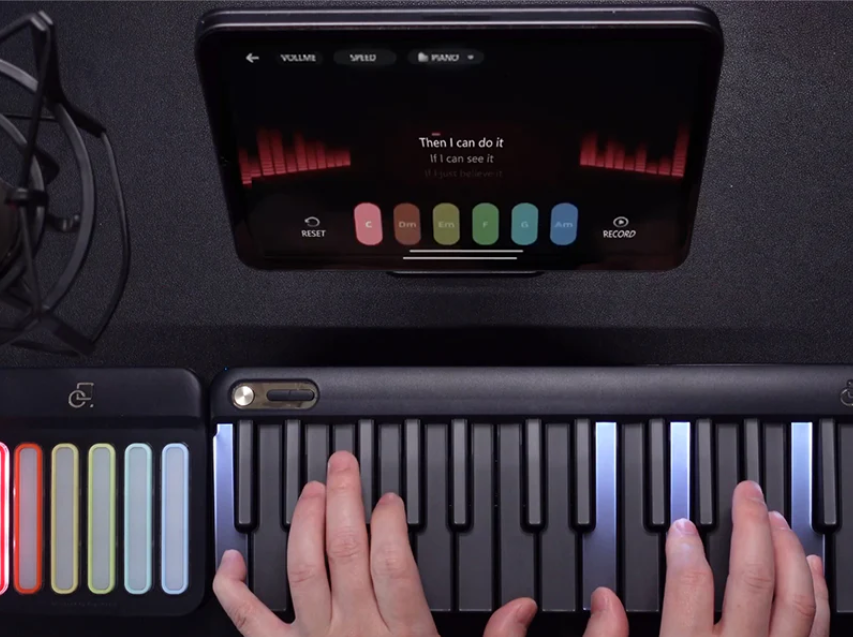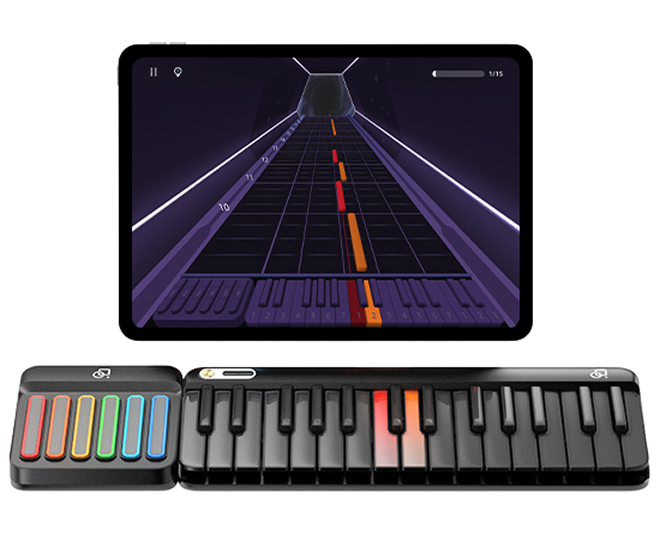
You’ve probably noticed that “keyboard” gets tossed around to describe just about anything with black‑and‑white keys. Yet walk into any music store (virtual or brick‑and‑mortar) and you’ll see dozens of very different instruments all wearing the “piano keyboard” label.
Weighted, unweighted, micro‑sized, fully‑featured, packed with lights, it’s a lot. This guide breaks down the types of piano keyboards you’ll run into, shows who they’re best for, and drops a few buying tips so you can choose with confidence.
Digital console pianos mimic the look and footprint of a classic upright. They come with a built‑in stand, three pedals, and weighted 88‑key actions that feel surprisingly close to acoustic hammers.
Brands like Yamaha’s Clavinova series or Roland’s HP line pack multispeaker systems and sample‑based tone engines that capture grand‑piano character without requiring annual tuning.
Shrink a console piano, ditch the furniture cabinet, and you get the portable digital piano. Instruments like the Roland FP‑30X or Yamaha P‑225 shave weight to roughly 26 lbs yet preserve 88 weighted keys, onboard speakers, and realistic piano samples.
Here’s where things get fun. Smart keyboards marry light‑guided keys, app‑based lessons, and social sharing into one playful ecosystem. The Smart Keyboard, for instance, uses glowing mini‑keys and a friendly app to teach chord shapes, popular songs, and even full two‑hand arrangements. You follow the lights, earn scores, and unlock “gaming” practice modes that keep motivation high.
Arrangers cram hundreds of auto‑accompaniment styles (pop, jazz, ’80s synthwave—you name it) under the hood. Press one finger on the left hand, and the keyboard generates a full rhythm section in real time. High‑end examples like Korg’s Pa5X even display lyrics on a screen for live karaoke.
Think of a workstation as the Swiss‑Army knife of keyboard piano culture. You get deep synthesis engines, multitrack sequencers, drum machines, and sometimes audio recording.
Strip away the sequencers of a workstation, beef up piano and electric‑piano sounds, add a rugged chassis—voilà, the stage piano. Models such as Nord Grand or Roland RD‑2000 focus hard on realistic keybeds, quick sound switching, and direct‑access knobs for EQ and effects.
While many keyboards include synth engines, dedicated synthesizers like the Sequential Prophet‑6 or Arturia MiniFreak lean all the way into analog oscillators, filters, and modulation routings. Key counts vary from compact 37‑key stabs to full 61‑key beasts.
A MIDI controller makes no sound on its own; it’s a hardware “remote” for virtual instruments inside a computer or tablet. That minimalism slashes cost—Novation Launchkey and Arturia KeyLab models start well under $300—and keeps weight featherlight.
Hybrid pianos fuse real wooden actions with digital sound engines. Yamaha’s AvantGrand and Kawai’s Novus series replace strings with speaker arrays yet preserve the hammer movement your fingers expect.
Activate “silent” mode and you can practice at 2 a.m. through headphones without waking roommates.
The shorthand above is helpful, yet the “best piano keyboards” for one player can be a mismatch for another. Use the checkpoints below to refine your search:
|
Player Profile |
Best Fit |
Why It Works |
|
First‑week Beginner (Kids or Adults) |
Smart Keyboard / Portable Digital Piano |
Light guidance, built‑in lessons, quick setup, wallet‑friendly. |
|
Serious Student |
Digital Console Piano |
88 weighted keys, pedal realism, headphone practice. |
|
Bedroom Producer |
MIDI Controller + DAW |
Endless software sounds, minimal space, budget control. |
|
Gigging Singer‑Songwriter |
Arranger or Stage Piano |
Portable, easy splits, quick sound changes mid‑set. |
|
Film/Game Composer |
Workstation Keyboard |
Deep synthesis + sequencing without a laptop. |
|
Traditional Pianist in an Apartment |
Hybrid/Silent Piano |
Acoustic feel, digital volume control, and recording options. |
So many spec sheets toss around terms like graded hammer, semi‑weighted, and aftertouch that it can feel like alphabet soup. A quick decoder ring:
Keyboard shopping shouldn’t feel like cramming for a physics exam. Identify your goals, match them to the different types of piano keyboards outlined above, and you’ll narrow the field fast.
Leer más

Understanding What an Electric Piano Is Called & How It Works
You’ve probably heard folks say “electric piano,” “keyboard,” or “digital piano” as if they’re all the same instrument. Yet search engines still get the question “what is an electric piano called” ...

Keyboard or Digital Piano? What Beginners Need to Know Before Buying
Walk into any music shop—or scroll through a few online listings—and the words keyboard and digital piano start blurring together. Both have black‑and‑white keys, both promise “great piano sound,” ...